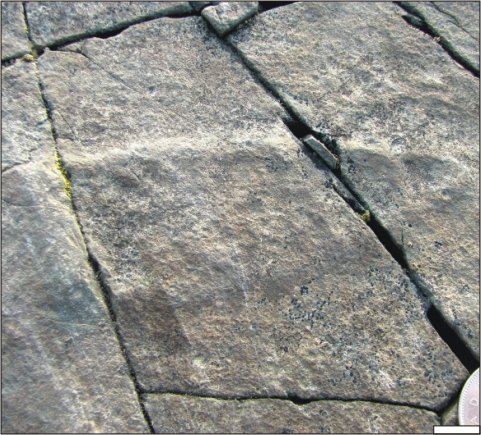2009 Annual Science Report
 Massachusetts Institute of Technology
Reporting | JUL 2008 – AUG 2009
Massachusetts Institute of Technology
Reporting | JUL 2008 – AUG 2009
Paleoecology of the Mistaken Point Biota
Project Summary
The origins of animals has remained shrouded in mystery since the origins of paleontology, principally because of their abrupt appearance in rocks dates at around 530 Ma with little or no sign of possible antecedents in Precambrian rocks. This does not mean though that older rocks are devoid of life – indeed rocks of the last half of the Ediacaran period (~580-542 Ma) are chock full of interesting but enigmatic and unmistakably non-animal forms. Maybe the most interesting of these are the rangeomorphs, fractally-organized organic forms seemingly designed to feed on dissolved nutrients in the sea water via passive absorption across their bodies. Curiously modern sponges are also designed to feed on nutrients extracted directly from sea water, but they do so in a fundamentally different manner. Why would these rocks have one type of organization but not the other when both work equally well, all things being equal? Our recent exploration of these rock in the Mistaken Point sections of Newfoundland have revealed that one already described taxon, Thectardis, might indeed be a sponge, and as such the oldest known macroscopic animal form.
Project Progress
The Mistaken Point Ecological Reserve is ideal for the study of early life because it represents the oldest radiometrically-dated section with true macroscopic fossils known (Narbonne and Gehling, 2003; Bowring et al., 2003), and its sediments were deposited in deep water well below storm wave base and the photic zone (Wood et al., 2003). Such environmental constraints prohibit any photoautotrophic lifestyles typical of plants and algae, and help constrain the implied affinities of the organisms present to heterotrophic lineages such as metazoans and fungi (Clapham and Narbonne, 2002; Peterson et al., 2003). Sedimentological studies have identified the presence of deep ocean currents which were likely responsible for the transport of oxygen and perhaps dissolved organic carbon (DOC) into these deep water assemblages, allowing for the proliferation of macroscopic Ediacaran organisms. Amongst the fossils present, the overwhelming diversity, disparity, and numerical abundance is dominated by the Rangeomorphs, an extinct clade of modular organisms that relied on fractally-repeated branching to increase their surface area to volume ratios necessary for the absorption of DOC directly through their integument (Sperling et al., 2007; Laflamme et al., 2009). Rangeomorphs likely represent an independent clade outside of crown-group Metazoa (Sperling et al., 2007; Xiao and Laflamme, 2009), and no known animal fossils were identified in these deposits (Peterson et al. 2003). Nonetheless, our recent NASA Astrobiology Institute “Advent of Complex Life” field trip to Mistaken Point in September, 2009, led us to identify an unusual fossil called Thectardis as the oldest macroscopic animal fossil. Clapham et al. (2004) were the first to describe Thectardis, a peculiar, triangular-shaped fossil from the Drook and Mistaken Point formations of Newfoundland, and compared taphonomic variance within the triangular shape, as well as overlapping relationships with other closely associated taxa, to suggest that the most parsimonious shape and life-habit for Thectardis was an inverted cone stuck to a microbially-bound substrate (“mat-sticking” lifestyle of Seilacher, 1999). They further drew attention to the remarkably constant length to width ratio in these forms, which favored an increasingly large distal “aperture” as the cone-shape lengthened Our reevaluation of Thectardis suggests that this form is indeed an animal fossil, specifically a sponge, although not necessarily related to any living sponge group. This fossil assemblage suggests that at least two forms of macroscopic eukaryotic life evolved independently to feed on DOC, sponges and rangeomorphs, but only the latter left descendants after the demise of the “Rothman” ocean and the end of the Ediacaran period.

Figure 1: Thectardis avalonensis from the Ediacaran Drook Fm. of Newfoundland, Canada. Cone-shaped sponge displaying internal ornamentation consisting of several horizontal to V-shaped cross-bars. Taphonomic studies confirm that the narrow (tapering) end of Thectardis was proximal and anchored to the substrate, with the broad distal opening serving as a likely excurrent canal. Scale bar 1 cm.
-
PROJECT INVESTIGATORS:
-
RELATED OBJECTIVES:
Objective 4.2
Production of complex life.


